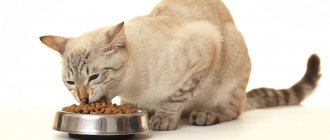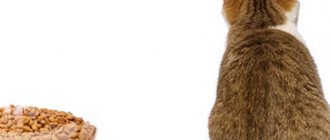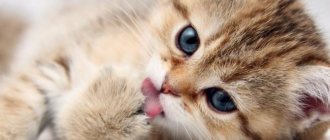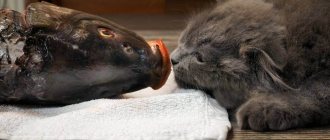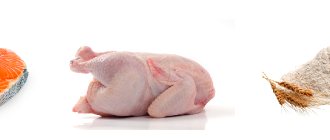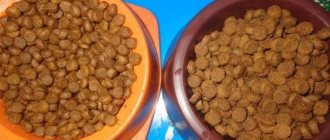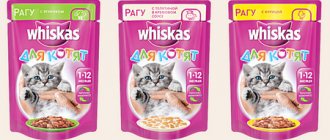general information
Whiskas is an international brand of cat food. The products are produced by the Petcare division, which is part of the Mars company. This corporation also produces Pedigree dog food, Kitiket and Royal Canin.
Whiskas food began to be produced in 1958. It became the first brand under which several types of ready-made diets with different flavoring additives were developed, which was one of the reasons for the rapid spread of popularity.
The logo is present on all packaging of Whiskas cat food
Whiskas products belong to the economy class. This means that the proportion of meat in the composition is too small, so ready-made diets should not be used for systematic feeding of cats.
Description of mini fillet
The new product is intended for adult pets and is available in two flavors: beef and chicken. It has a soft, homogeneous gelatinous consistency. Mini-fillet is well absorbed in the stomach, having a beneficial effect on its mucous membrane, without causing problems with digestion and stool.
The feed includes:
- Omega-6;
- taurine;
- phosphorus;
- football;
- vitamins A and E,
- calcimine;
- zinc;
- phosphorus;
- flakes.
The meat content in the product with both flavors, including offal, is only 4.
Find out now if you should feed your pet Frisky. Read customer reviews. Leave your review about this product.
Brand history
Whiskas was the first animal food product to be commercialized by the American company Mars. This happened in 1932, and now in terms of sales it is in first place among industrial diets for cats in the world. Divisions of this company are located all over the world, but the main representative office of Mars Petcare is located in Belgium, in Brussels. In 1991, the company began operating in Russia, and already in 1995, the first plant for the production of food for pets opened in Stupino. At the moment, there are already several feed production factories in the Russian Federation.
The pride of the company is the Waltham research and development center, located in the UK. Leading experts in the field of veterinary medicine and pet nutrition are developing new concepts that are used in ready-made food formulas for cats. One of the most famous achievements of this laboratory is the recognition of the important role of taurine in the body of cats.
Cats are not able to produce this substance on their own and can only get it from food, so Whiskas was the first food to which it was added. This was a significant breakthrough in the field of ready-made diets for domestic cats. Currently, all complete feeds include taurine.
Types of Whiskas feed
The company produces 4 types of food: for kittens (from 1 to 12 months), for adult cats (from 1 to 7 years), for older animals (over 7 years) and for sterilized pets. Additionally, they produce products from the “Appetizing Mix” line. They produce both spiders and granulated dry food.
The company is ready to offer many different types of food, but in reality there are no significant differences between them
The lines contain only everyday ready-made diets. There are no medicinal feeds. The composition of different products from the same line differs slightly, so it is not advisable to consider the list of ingredients for each ready-made diet.
Kitten food
The line of food for kittens includes spiders and pads with filling. The first option is better, because it is easier for animals to digest a wet product.
Dry food
Whiskas pads for kittens with carrots, turkey and milk are suitable for animals from 2 to 12 months. This is due to their texture and relatively high fat content. It is not recommended to give dry food to small kittens under 2 months, as the dense consistency will cause digestive upset. As a last resort, the granules are first soaked so that the stomach and mouth are less injured by dry pieces. After 12 months, it is recommended to switch your pet to a different diet so as not to cause the development of obesity.
Cardboard packaging is not completely sealed and allows air to pass through, so this is a controversial decision
The composition includes the following ingredients:
- Wheat flour;
- animal flour: poultry meal, turkey meal (at least 4% turkey in yellow, brown and red granules), meat and bone meal;
- rice;
- protein plant extracts;
- animal fat;
- sunflower oil;
- Brewer's yeast;
- vegetables (including carrots at least 4% in yellow, brown and red granules);
- dairy products (including milk powder, minimum 4% in pillows);
- vitamins;
- minerals and taurine.
The manufacturer claims the following benefits of the formula:
- Strengthening the immune system. The composition contains zinc and vitamin E, which help the kitten’s body synthesize its own antibodies after the loss of maternal antibodies obtained with milk.
- Improving the condition of coat and skin. Zinc, vitamins A and E, as well as omega-6 unsaturated fatty acids help increase the production of skin secretions. The lipid film retains moisture in the skin and acts as a lubricant, enhancing the shine of the coat.
- Strengthening vision. Taurine and vitamin A promote normal organ development and prevent the development of eye pathologies.
- Improved bone health. Calcium and phosphorus strengthen the musculoskeletal system. The risk of fracture is reduced.
- Normalization of digestion. Plant ingredients (cereals and carrots) contain fiber, which enhances peristalsis and prevents constipation.
- Cleansing the oral cavity. Dry granules help remove plaque and prevent the formation of tartar.
There are 2 packaging options: 350 g and 1.9 kg. Large packages are more economical, but with slow consumption, the food will begin to deteriorate due to contact with air. For small kittens, it is more advisable to purchase packages of 350 g.
I would not give my kitten this food. I am personally familiar with cases where animals developed pancreatitis after such feeding. Childhood is an important period for a kitten’s body. At this time, the formation of many internal systems is completed, so the animal requires enough nutrients. There are too few of them in Whiskas products. The balance is artificially brought to normal with the help of mineral supplements, fats and vegetable protein, but in fact the nutritional value is low. There is almost no meat. This is the same as feeding a cat machine oil, calfskin and millet: it looks like there are carbohydrates, proteins and fats, but there is zero benefit.
Wet food
Wet food can be given to animals from 1 month. The increased water content and soft consistency facilitate digestion. The line contains the following products:
- lamb stew;
- chicken stew;
- salmon stew;
- veal jelly;
- turkey jelly;
- chicken pate.
Feeds differ in texture. Ragout consists of pieces of meat with a liquid sauce. The gravy in jelly is thicker. The paste is homogeneous in consistency.
It’s easier for kittens to eat wet food because it’s easier to chew it with their baby teeth
The composition differs slightly, so for example, consider the list of ingredients for chicken stew. The food contains the following components:
- meat and offal (including chicken at least 4%);
- cereals;
- vegetable oil;
- taurine;
- vitamins;
- minerals.
The manufacturer claims the following advantages:
- The presence of vitamin E in the composition. Tocopherols are essential for the proper functioning of the immune system and the maintenance of optimal skin and coat condition. Vitamin E is involved in the synthesis of new cells and enhances the production of sebaceous secretions.
- Presence of calcium. The mineral helps strengthen bones and teeth.
- High content of zinc and omega-6. The substances cause increased activity of the excretory glands, which protects the skin from drying out and peeling.
- The presence of taurine and vitamin A. Useful substances are necessary for the formation of visual organs.
Wet food for kittens contains more fat, so it can be used to feed malnourished animals.
Cats are not able to synthesize taurine from other compounds on their own, so it must be present in the food.
Spiders weigh 85 g. Sometimes you can find packages of several packs on sale. This allows you to save a little due to a discount for bulk purchases.
Large packages are more common in online stores
Not the best option for a kitten. The manufacturer suggests giving ready-made diets from 1 month, i.e. practically as the first complementary food. Once, due to my own inexperience, I offered such food to a street kitten I took home. He started vomiting. If there are no other options, it is advisable to give spiders to animals only after 2 months, when digestion has improved a little. Until this point, even a single feeding can cause serious disruption, including dehydration due to vomiting and diarrhea. In some cases this leads to death.
Food for adult cats
Food for adult cats is available in 2 versions: wet and dry. It is recommended to give granules only to those animals that independently comply with the drinking regime and do not suffer from diseases of the genitourinary system. A cat should consume at least 20–40 ml per 1 kg of weight per day.
Dry food
The company produces pate pillows in 3 flavors: salmon, chicken and turkey, and beef and rabbit. Generally speaking, the food is suitable for healthy animals from 1 to 7 years old.
The range of wet and dry Whiskas food for adult animals is the widest
The composition of different products is identical. Minor differences are associated with the types of meat used. For example, consider the composition of pillows with beef and rabbit meat. The list of ingredients contains the following components:
- Wheat flour;
- animal flour: poultry meal, beef meal, lamb meal, rabbit meal (beef, lamb and rabbit at least 4% in red-brown granules);
- plant protein extracts;
- cereals;
- animal fats and vegetable oils;
- dried chicken and pork liver;
- Brewer's yeast;
- beet pulp;
- carrot;
- mineral and vitamin mixtures.
The benefits declared by the manufacturer are the same: the presence of vitamins and minerals in the composition, strengthening the immune system and bones, supporting the development of the visual organs, etc. There are 3 packaging options: packages of 350 g, 800 g, 1.9 kg and 5 kg.
One day, a neighbor who had 2 cats at home came to me for advice. She said that the pets were in terrible condition and asked for help. The animals' fur fell out in clumps, leaving bald patches with itchy red spots. The skin came off in layers. There was no dandruff only on the stomach. I advised her to contact a veterinarian, but during the conversation it turned out that the neighbor gives her cats Whiskas food. She was very surprised to find out that this was one of the worst products, and the next day she began switching the animals to a super premium diet. During the examination, the veterinarian said that this was a severe allergy and supported the decision to change the food. After 2 weeks, the cats stopped scratching themselves until they bled, and the spots disappeared. After a month, the wounds healed, and hair began to grow on the bald areas.
Wet food
Based on consistency, wet food is divided into stews, pates, jellies, cream soups and mini-fillets. The cream soup additionally includes plant-based dry cream. The mini fillet has a consistency similar to stew. Flavorings include salmon, trout, veal, beef, turkey, etc.
There are no fundamental differences in composition, so for example, let’s look at jelly with turkey and vegetables. The list of ingredients contains the following items:
- meat and offal (including turkey at least 4%);
- vegetables (carrots at least 4%);
- cereals;
- taurine;
- vitamins;
- minerals.
The benefits declared by the manufacturer are the same. One spider weighs 85 g.
On average, pets need 2-3 spiders to get enough food
I am glad that the composition contains animal products in the first place, but I would not rush to boldly call this a full-fledged plus. Once upon a time, a friend of mine worked at one of the factories producing economy-class feed. She said that if people knew what was included in such products, they would never buy ready-made diets in their lives. I don’t know whether to believe it or not, but the general definitions (“meat,” “offal,” “turkey,” “vegetables,” and “grains”) are confusing. Among the same offal there may be liver, kidneys or hearts, as well as bladders or intestines. Many super-premium and holistic food manufacturers specify a specific type of ingredient. In the case of Whiskas products, everything is not so transparent. This makes you think: if everything in the composition was good, the manufacturer would have nothing to hide.
Food for older cats
The line of food for older cats is smaller: it contains only one granular product and 3 types of spiders. Ready-made diets are suitable for animals over 7 years old.
Dry food
The only representative is pillows with poultry pate. Theoretically, the porous texture with soft contents helps reduce stress on the teeth. The pet has to make less effort to break the granule, which partially prevents damage to the enamel and roots.
Your pet does not need to be switched to a different diet if it receives vitamin and mineral supplements as prescribed by a veterinarian
The food contains the following ingredients:
- Wheat flour;
- animal meal: poultry meal (minimum 4% in brown granules), meat and bone meal;
- protein plant extracts;
- rice;
- animal fat;
- sunflower oil;
- Brewer's yeast;
- vitamins;
- minerals and taurine.
The manufacturer claims that the composition contains glucosamine, which is necessary to maintain healthy joints. One of the advantages is a special formula to improve appetite, but the composition of the product is identical to others. Buyers can only guess what exactly keeps animals interested in the product. Most likely, these are artificial flavors that do not provide any benefit, but can cause harm. Theoretically, the caloric content of the food is lower than that of others, since weight maintenance is stated among the benefits, but the manufacturer does not disclose the nutritional value of the product on the website.
Large packages are not available for sale. The food is produced in small cardboard packs of 350 g.
The lack of specifics and general formulations cause distrust in the company. For example, the manufacturer claims that dry food helps clean teeth from plaque. For this purpose, special porous granules are produced that do not crack when pressed with fangs, but fall inside. Because of this feature, surrounding particles clean the surface of the tooth down to the roots. I specifically conducted a small experiment. In the case of Whiskas food, nothing like this was observed: the cat simply bit into the granules while eating. Perhaps the manufacturer is not lying, because such a product also cleans the tips of the fangs, but it is difficult to call this complete care. To prevent the cat from losing teeth in old age, owners will have to additionally use a special brush for animals.
Wet food
The company produces 3 types of wet food for older animals: chicken stew, lamb stew and veal pate. The composition is almost identical, however, in the pate the proportion of the declared meat component is much higher compared to analogues: 24% versus 10% and 4% in different types of stews. It also contains no grains.
It is recommended that older animals be given wet food to reduce the stress on the teeth and gastrointestinal tract.
For example, consider the composition of lamb stew. The list of components mentions the following items:
- meat and offal (including lamb at least 4%);
- cereals;
- vegetable oil;
- taurine;
- vitamins;
- minerals.
The benefits are the same as other foods. The only fundamental difference is the presence of glucosamine and components (possibly flavorings) to enhance appetite.
Food for sterilized animals
The line contains only dry food. There are 2 flavors available to choose from: chicken and veal.
The absence of wet food in the line for sterilized animals is a questionable decision
For example, consider the composition of chicken feed:
- Wheat flour;
- animal flour (including chicken flour at least 4% in brown granules);
- protein plant extracts;
- rice;
- animal fats and vegetable oils;
- dried chicken and pork liver;
- Brewer's yeast;
- vitamins and minerals.
The manufacturer states that the finished diet contains the optimal ratio of substances to maintain the health of the urinary system. However, the company does not specify what exactly helps maintain the normal state of internal organs. The composition does not differ from similar products. Perhaps the special feature of the food is its low salt content, but when it comes to the health of your pet, you don’t want to guess, but to know for sure. The product is available in packages of 350 g, 1.9 kg and 5 kg.
I don’t know how food for sterilized animals differs from regular food, but I suspect it’s only in name. I personally know of 2 cases where cats developed urolithiasis after such a diet, and I regularly encounter negative comments and reviews. After my pet was neutered, the veterinarian told me what the diet should be. If this is a ready-made diet, then it should contain a minimum of salt (only for the natural needs of the body and to preserve moisture), the presence of natural preservatives and additives to normalize the acidity of urine is welcome. It is advisable to prefer wet food, since the liquid promotes timely emptying of the bladder and prevents the increase in the saturation of urine with minerals. This prevents the formation of stones. Whiskas dry food does not meet these criteria, so it is not recommended to give it to animals after sterilization or castration.
Line “Appetizing mix”
The line includes 4 types of wet food: chicken and duck with cheese sauce, lamb and beef with cream sauce, poultry and beef with tomato jelly and shrimp with salmon and cream sauce. The composition is almost identical. The main difference is the flavoring additives. Depending on the type of food, it can be cheese or tomato powder, as well as a milk-containing product.
Tomato jelly with beef and poultry contains the following ingredients:
- meat and offal (including poultry and beef);
- cereals;
- vegetable oil;
- tomato powder;
- taurine;
- vitamins;
- minerals.
The “Appetizing Mix” line of food differs from similar products only in the presence of flavoring additives and, possibly, the percentage of components. While other ready-made diets indicate minimum contents of certain ingredients, these products do not contain specific information.
How Kitekat food affects your pet's body
It is believed that cheap food can do nothing but harm to a cat. This is explained by the characteristics of the composition:
- Products processed from animal components (bone meal, feathers, hooves, beaks, etc.) may be of too low quality.
- Dyes, preservatives and other artificial ingredients poison the body.
- Corn and yeast can cause allergies.
- The food contains flavorings and taste enhancers, which means that the cat can get used to the food.
Many cat owners who fed their pets “Kitiket” attribute all their “sins” to this food when the animal gets sick. Veterinarians strongly recommend feeding their patients exclusively high-grade food. But this question can be looked at from the other side:
- Cheap ingredients (offal) are normal food for cats. In the wild, they feed on mice, birds, etc. Such components are valuable for the presence of protein.
- Dyes are also found in some expensive foods, and all food dyes are allowed by different standards. And preservatives are absolutely necessary to ensure that the food does not spoil.
- Allergens are sometimes found in holistic foods. The characteristics of the composition are determined by the manufacturer himself, especially since not all cats have allergies.
- Flavorings are needed not to cause addiction, but to give the animal an appetite, because it affects digestion.
I often hear from cat owners phrases like “Kitiket is poison”, “It’s all chemicals”, “They add drugs to this food”, etc. I think this is all exaggerated. Buying cat food is similar to choosing human food. For example, if a person does not have money for a piece of fresh boneless beef, then he will buy inexpensive sausages or sausage. Sausages, for example, also contain dyes, flavors, preservatives and the same by-products. People understand that it is not very useful, but they still buy it. So does cat food. Everyone buys food within their budget.
Despite a large number of angry reviews, cat owners continue to buy these products
If economy class food is produced and it is permitted by law, it means that it does not have to be harmful to health. But you need to remember to follow the feeding rules:
- You cannot mix natural food and ready-made food (as well as food of different brands). Each food is balanced in its own way, and when mixed, this balance is disrupted. For example, you cannot feed your cat “Kitiket” and raw fish - this leads to severe attacks of urolithiasis.
- If we are talking about dry food, then you need to take a more serious approach to the drinking regime (there should be plenty of water, otherwise it will have a bad effect on digestion and kidney function).
- There is no need to “stuff” your cat with vitamins and various supplements without the recommendation of a veterinarian (this also upsets the balance).
- You need to carefully follow the manufacturer's recommendations (volume and number of feedings) so that your pet does not have to be fed with natural food.
- Nursing and pregnant cats need to be fed more often to prevent them from starving.
When is it contraindicated to give them to a cat?
There are animals that are not recommended to be fed with such food:
- cats with urolithiasis or kidney failure;
- kittens under 1 year of age (they need a differently balanced diet);
- cats and cats prone to allergies.
My sister's cat has urolithiasis. For two years he ate mainly fish, which led to the development of the disease (according to the veterinarian, fish is one of the provoking foods, as it contains a lot of phosphorus). The veterinarian prescribed treatment and recommended switching the cat to complete industrial food. My sister bought Kitiket, but experts advised replacing the food with a veterinary diet (super premium food).
Kitekat food is contraindicated for kittens, allergic cats and animals with urolithiasis
What are the consequences
Feeding your pet with ready-made food is quite simple, quick and inexpensive. However, few owners think about the possible consequences of such a diet for their pet.
Veterinarians point to the following diseases and pathological conditions that develop in cats whose menu is based on Whiskas and other economy-class foods:
- gastritis;
- ulcerative lesions of the gastrointestinal tract;
- bouts of vomiting;
- liver pathologies;
- development of dependence on food, refusal of other foods;
- kidney diseases;
- sand and stone formations localized in the kidney area;
- hair loss;
- skin, dermatological diseases;
- lethargy, passivity;
- development of obesity;
- the appearance of dandruff and skin rashes;
- pancreatitis.
Clinical studies have shown that cats fed Whiskas require more water. Thus, when eating 100 g of food, an animal must consume at least 250 ml of liquid, which is virtually unrealistic. Lack of proper drinking regime leads to serious problems with the kidneys and urination, increased urine concentration, and the formation of sand and stones.
If you constantly feed Whiskas to a small kitten, you can provoke delays in its development, a weakened immune system and an increased susceptibility to various kinds of diseases. Possible unwanted side effects include allergic reactions.
We suggest you read: How to treat a cat with poisoning
The results of the studies have proven that domestic cats that feed exclusively on Whiskas and often consume this food live on average no more than 5 years. At the same time, the average life expectancy of cats whose owners provide an optimally balanced menu is at least 10-15 years.
Composition analysis
The food is almost identical in composition, so it is enough to consider 1-2 samples. As an example, let’s look at the list of ingredients for pads with beef and rabbit meat for adult cats:
- Wheat flour;
- animal flour: poultry meal, beef meal, lamb meal, rabbit meal (beef, lamb and rabbit at least 4% in red-brown granules);
- plant protein extracts;
- cereals;
- animal fats and vegetable oils;
- dried chicken and pork liver;
- Brewer's yeast;
- beet pulp;
- carrot;
- mineral and vitamin mixtures.
Wheat flour comes first. This is a source of plant proteins and carbohydrates, which the cat practically does not need. Most of the nutrients are not absorbed by the pet’s body, since carnivores have a short gastrointestinal tract adapted to digesting products of animal origin. Wheat can be harmful to a cat's health. It relatively often causes the development of allergies.
The manufacturer claims that the food contains no dyes, but this is hard to believe
The only animal products included are flour and liver. The share of the latter is comparable to the amount of brewer's yeast and vegetable oil, so it can be ignored. Animal flour is in 2nd place. It is obtained not only from pure meat, but also from industrial waste, feathers, bones, scales, etc. Such a source of protein cannot be called high-quality. In addition, the share of rabbit, lamb and beef does not exceed 4%. Judging by the manufacturer's clarification, these varieties are contained only in red-brown granules. The rest contain cheaper birds.
In total, the proportion of plant protein extracts, wheat flour and cereals is much higher than the amount of animal flour. This reduces the nutritional value of the product for cats.
Animal fats and vegetable oils help bring the nutrient balance to optimal. Unfortunately, the manufacturer does not indicate the specific type of products, so the buyer can only guess about their quality. The same goes for cereals.
The advantages include the presence of carrots and beet pulp. These are sources of fiber that aid digestion and promote the movement of stool. Coarse plant fibers cleanse the intestinal walls and remove rotting food particles.
Let's look at the composition of wet food for kittens (chicken stew):
- meat and offal (including chicken at least 4%);
- cereals;
- vegetable oil;
- taurine;
- vitamins;
- minerals.
The clarification about the minimum share of chicken is alarming, because 4% is very little for wet cat food. It is not specified what other sources of animal protein the product includes. The need for the presence of grains in a ready-made diet is questionable, so their presence in such quantities (2nd position) is a minus. Vegetable oils can be useful provided that high-quality raw materials are used and in a relatively small volume. The percentage of components and their type are not specified, so one should suspect the worst. Low-quality oils cause digestive upset and increase the load on the pancreas. Taurine, vitamins and minerals are standard feed additives. Their proportion and type have not been specified, so it is impossible to draw any conclusions.
Whiskas feed is more reminiscent of grain mixtures in composition. Such products are definitely not suitable for cats. Buyers largely have to guess about the composition of feeds. If you compare Whiskas with any product of at least super-premium class, the difference will be obvious: there are specific items in the list of ingredients. The best dry food in the entire line can be called a product for kittens. The difference is that it contains a higher proportion of rice than protein plant extracts (presumably by-products), but it also often causes nausea in animals. My colleague once tried to feed a malnourished adult cat taken from the street with it. The animal suffered from vomiting until it was switched to baby food and Acana food.
Feed to replace “Kitiket”
Kitekat can be replaced with other food, for example:
- "Purina One"
- "Night Hunter".
- Royal Canin.
- "Eukanuba"
- "Bosch" (Bosch Sanabelle).
- "Hill's".
- Pronature Original.
- "Innova Evo"
- "Leonardo"
- Pronature Holistic.
Comparison table: replacement feed
| Name | Class | Type of feed | Presence of protein | Presence of dyes and flavors | Price |
| Purina One | Economy | Dry | Up to 34% | Flavor with added bifidobacteria | From 290 rubles for 750 g |
| Night Hunter | Dry, wet | Up to 33% | Not indicated | From 70 rubles for 400 g | |
| Royal Canin | Premium | Up to 38% | Flavoring additives | From 250 rubles per 400 g | |
| Eukanuba | Up to 35% | Not indicated | From 450 rubles for 800 g | ||
| Bosch Sanabelle | Super premium | Dry, semi-moist | Up to 33% | From 1300 rubles for 2 kg | |
| Hill's | Dry, wet | Up to 40% | Does not contain dyes, but does contain flavoring additives | From 1300 rubles for 1.5 kg | |
| Pronature Original | Dry | From 30% | Flavorings and natural flavors | From 200 rubles for 350 g | |
| Innova Evo | Holistic | From 50% | Natural flavors | From 1300 rubles for 2 kg | |
| Leonardo | Dry, canned | From 32% | Not indicated | From 380 rubles per 400 g | |
| Pronature Holistic | Dry | Up to 33% | Natural chicken flavor | From 350 rubles for 340 g |
Photo gallery: food of different classes
“Purina Van” is an economical analogue of Kitekat, but veterinarians sometimes recommend it even for sick cats
“Night Hunter” is a relatively new Russian brand that is gaining popularity
The Royal Canin brand offers everyday food for kittens and cats of various breeds, as well as special diets
The manufacturer indicates that 41% of the specified proteins are poultry meat
indicates in detail the composition (except for artificial components)
Hills has various veterinary lines, food for kittens, as well as separate series of food that are close in composition to natural food
Pronature Original is only dry food intended for kittens and adult cats
A distinctive feature of Innova Evo is that it is completely grain-free food
80% of protein (in 33% of those indicated) is a product of animal origin, including poultry meat
Pronature Holistic is one of the few luxury brands that offers its customers a variety of tastes
Is it worth replacing Kitiket with another economy class food?
Whether or not to replace Kitiket with another economy class product is up to the cat owner to decide. If you trust your usual food, then changing one for another is pointless.
Feeding standards
Until the kitten reaches 12 months of age, it should only be given kitten food. To determine the daily and single dose, you need to know the weight of the animal. The norms are calculated to cover all the nutritional needs of the cat, but Whiskas is not a complete food in composition, so the portions are larger than those of premium foods. With a mixed diet, dry and wet foods are divided into several meals. The box or packaging contains information about the amount of food calculated for the pet's weight. The norm can be adjusted based on the needs of the pet. When feeding dry food with meat or fish, you need to make sure that the amount of water you drink is three times the serving of pads. One-time standard factory food for the weight of an adult pet
| Cat weight, kg | Calories per day | Dry form, gram | Wet, gram |
| 2—3 | 170 | 45 | 200 |
| 4—5 | 250 | 55 | 250 |
| 5—8 | 300 | 65 | 300 |
Reviews of Kitekat food from cat owners
I fed the cat Purina, Hills, Royal, Happy Cat, Friskies, Our brand and Kitekat - I honestly didn’t see the difference. Just as a cat had difficulty going to the toilet on liquid food, she went to the toilet on dry food. As soon as we switched to natural food - porridge with liver, fish, chicken eggs - the cat began to go to the toilet normally.
batareyka, forum user
https://otzyvkorm.ru/kitekat-dlya-koshek/
They could have put in more chicken, but for 12.90 rubles it’s probably the best (this includes the store’s trade markup, packaging, and the maintenance of the manufacturer’s staff). I thought that there was only soybean, but the manufacturer draws our attention to the fact that there is NO soybean there!
listok44, forum user
https://irecommend.ru/content/esli-malo-vremeni-kot-ochen-golodnyi-na-pomoshch-pridet-kitekat
Advantages and disadvantages of food
The disadvantages of feed include the following factors:
- Low content of meat ingredients. If it is dry food, they are below the first position. If wet, a large proportion of the composition is occupied by water and grains.
- Lack of percentage of components. There is no specific information available, so buyers cannot be sure of the quality of the food.
- Using low quality ingredients. If these are cereals, then they are not whole or even presented as a protein extract. Flour is used as meat products.
- Lack of specific information. The manufacturer does not indicate the ingredients used. This reinforces confidence in using low-quality components. Additionally, this causes inconvenience for cat owners prone to allergies.
- Veiled attempts at deception. For example, information about cleaning teeth with granules is only partially reliable. You can’t find fault here: any dry food removes some of the plaque from the ends of your teeth. However, a real preventive product should also clean the area near the roots. Buyers perceive these assurances as a guarantee of high-quality plaque removal.
- No fundamental differences between products. The composition of the feed is almost identical. Most often, the difference lies in the flavoring additives.
- Presence of the pesticide pirimiphos-methyl in trace amounts. The violation was discovered during testing by Roskachestvo. Pirimiphos-methyl is an insecticide used on cereals. In small quantities, the toxin increases the load on the stomach, liver and kidneys; in large quantities, it can cause cardiac arrest.
The angular pellets can cause your cat to accidentally injure the roof of their mouth or gums.
The list of advantages can only include the relative merits of the food. For example, according to the results of the study, the product contains no pests. In reality, all food (including economy class) must meet these requirements, so this is not a reason to be proud. Cats eat Whiskas products with pleasure and often refuse to switch to other ready-made diets, but this may be due to flavorings and flavoring additives.
Canned Frisks
Advantages:
- ready-made, balanced food that can be given to your cat daily (either on its own or in combination with dry food of the same brand);
- suitable for feeding kittens and adult animals;
- wet food causes a greater appetite than dry food; it does not have to be washed down with water;
- a wide range of;
- easy to find on sale.
Flaws:
- According to veterinarians, opened canned food at room temperature cannot be stored for more than 2 hours;
- the price is higher than that of dry food;
- belonging to economy class.
Useful information: shiny fur, good, playful mood, painless and timely defecation, absence of strong unpleasant odors from the mouth and from the tray of your mustachioed pet - this is a sure sign that the food is suitable for him. If you have any doubts, reconsider your view on the nutrition of a kitten at 4 months or consult a specialist.
It will be interesting:
- Hill's food reviews;
- Royal Canin cat food reviews;
- Acana cat food reviews;
- veterinarian reviews of Proplan for cats.
Which is better: Whiskas or Friskis?
To answer the question of which food is better, you need to consider the composition of Friskis products. For example, let's look at the list of ingredients of a dry ready-made diet for adult cats:
- cereals;
- meat and its processed products;
- vegetable processing products;
- vegetable protein;
- fats and oils;
- yeast;
- preservatives;
- minerals;
- vitamins;
- dyes;
- vegetables and antioxidants.
It is impossible to say unequivocally which food is worse. Friskies products also contain dubious ingredients and vague formulations. The share of meat components is also low. There is no fundamental difference in quality.
Friskies food, like Whiskas, belongs to the economy class
The cost of "Friskies" is lower. The price of the pouch is 15–20 rubles. Small (400 g) packages of dry food cost 70-80 rubles, medium (2 kg) - 300-350 rubles, large (10 kg) - 1400-1500 rubles. However, it should be borne in mind that purchasing economy-class products means saving on your pet’s health. Late examination and treatment at the clinic may be more expensive. In addition, low-quality feeds have low nutritional value, so animals require more of them than super-premium or holistic products.
There is such a thing in the world, you most likely know about it exclusively from chocolate bars and you most likely associate it with astronomy. For almost two years of working in the pet business, this word evokes very strong feelings. This company produces the following feeds: Whiskas, Kiteket, Pedigree, Chappie. Although Friscos is produced by the Purina company, its quality is completely similar to Mars food. This is the most popular animal food among ordinary people. The population judges them solely on television advertising (fortunately, these are practically the only foods that are advertised on TV, with the exception of rare promotions), as well as from the experience of their closest acquaintances, therefore, the population considers these foods to be almost one of the most serious in the pet business industry, many they are trusted, and if they are not trusted, it is solely due to distrust of dry food in general. In more professional areas, opinion was developed quite a long time ago, and a completely definite one was developed. (I mean the field of veterinary medicine, professional breeding (breeders, nurseries), the field of trade in pet supplies, just people who are very interested in how to feed animals correctly). The following joke has become established among veterinarians: Martian food is our bread, as long as Mars exists, we will always have work, the day of the death of Mars will be a black day for the entire veterinary industry, it will be the day of the collapse of veterinary clinics.
On behalf of the group Cats... Cats... Kittens... In good hands! MOSCOW
https://vk.com/topic-17296831_30129564
Owners' opinions were divided. Some argue that food should be selected individually, because Whiskas suits some cats better, while Friskies suits others better. Other pet owners say it's best to avoid both products.
Canned Frisks
Advantages:
- ready-made, balanced food that can be given to your cat daily (either on its own or in combination with dry food of the same brand);
- suitable for feeding kittens and adult animals;
- wet food causes a greater appetite than dry food; it does not have to be washed down with water;
- a wide range of;
- easy to find on sale.
Flaws:
- According to veterinarians, opened canned food at room temperature cannot be stored for more than 2 hours;
- the price is higher than that of dry food;
- belonging to economy class.
Useful information: shiny fur, good, playful mood, painless and timely defecation, absence of strong unpleasant odors from the mouth and from the tray of your mustachioed pet - this is a sure sign that the food is suitable for him. If you have any doubts, reconsider your view on the nutrition of a kitten at 4 months or consult a specialist.
It will be interesting:
- Hill's food reviews;
- Royal Canin cat food reviews;
- Acana cat food reviews;
- veterinarian reviews of Proplan for cats.
Reviews
As a rule, the number of detractors of Whiskas food does not greatly exceed the number of those who fed and continue to feed their cats with these diets.
Having looked at the reviews on various resources about the products of this brand, it is clear that there is a lot of negativity, and there are often comments and expressions in an extremely harsh form. However, it is worth considering the fact that people tend to leave feedback when they are full of indignation, and much less often when they are satisfied with everything.
Feedback from cat owners
For your reference, here are some of them:
Martha, pet - neutered cat:
“I’ve been giving Whiskas to my mustachioed one for several years now, he especially likes the different spiders. When he was a kitten, he ate for little ones, now they switched to diets for “1+” years. He himself is terribly picky, he refuses even expensive super-premium food, but Whiskas is always lame and begs for more. I don’t see any health problems, the cat is always playful and happy, and looks good. I don’t see the point in bothering and changing his diet.”
Julia:
“I’ll say right away, beware of cheap food! Our first cat lived for 12 years, and ate Whiskas-Kitiket all her life, she never had any health problems. Then we got a second cat, loved him and spoiled him with delicious jellies from bags, and he was generally ready to do anything for dry food. This went on for about 2.5 years, and I had no idea that this was unhealthy food. In the end, it all ended very sadly - we noticed that something was wrong with him and went to the vet. The diagnosis is acute renal failure. It was not possible to save him. The doctor said it was all due to bad food. Don't repeat my mistake if you love your pets."
Reviews from veterinarians
In contrast to the conflicting opinions of cat owners about Whiskas, reviews from veterinarians are more specific and leave no doubt. Most of them believe that this is a low quality product that belongs to the economy class of food for cats. Veterinarians do not recommend it as a daily diet, emphasizing that the composition of Whiskas food cannot satisfy the nutritional needs of cats and is not a balanced, complete diet. In addition, experts note that regular feeding of such food can lead to metabolic disorders and negatively affect the health of your pet.
Whiskas
Once upon a time, this food was trumpeted on all TV channels and written in almost every magazine, and the slogan “Your pussy would buy whiskey” attracted thousands of viewers. Over time, people have learned not to trust advertising, but to this day this food remains in demand and will not disappear from the shelves. What is his secret?
Is it worth buying Whiskas cat food? Pros and cons, prices, reviews from owners and veterinarians.


